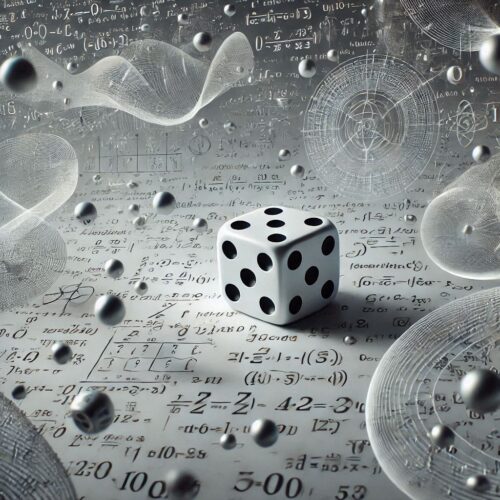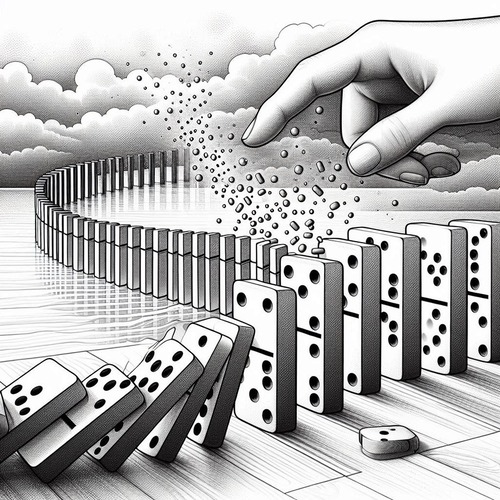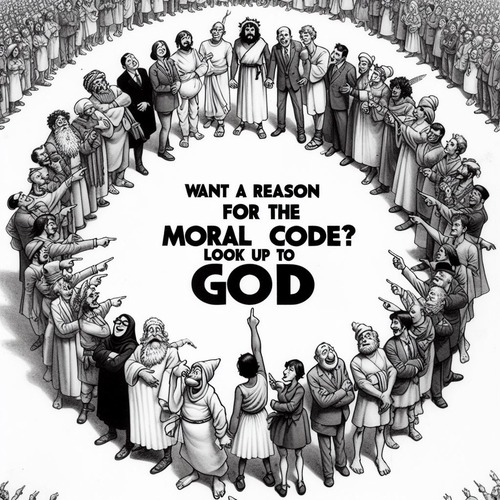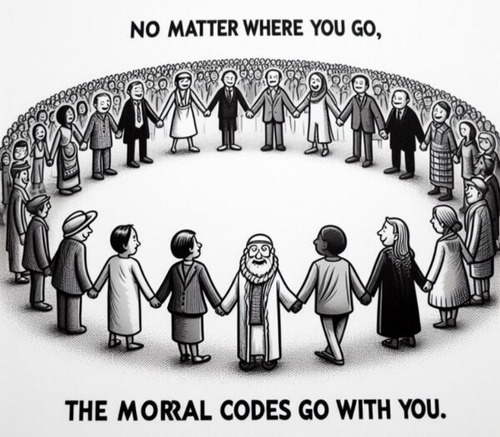Can Random Mutations Create Complex Life? The Math Says No
Can Mutations Create Life? Within each living cell lies an intricate universe of molecular machinery so complex that our most advanced supercomputers struggle to simulate even its simplest operations. A single bacterial cell contains millions of precisely arranged molecular components, all working in harmony to maintain life. The prevailing explanation for this complexity is that random genetic mutations—filtered through natural selection—created all these sophisticated systems. But does this explanation hold up under mathematical scrutiny?
WHAT ARE MUTATIONS AND WHY DO THEY MATTER?
Imagine DNA as an instruction manual for building and running our bodies. Just as any manual can have typos, DNA can have changes—these are mutations. They happen in different ways:
- Sometimes a single letter gets changed
- Sometimes a whole section might get copied twice
- Sometimes parts get accidentally deleted
- Sometimes pieces get rearranged
Some scientists believe these DNA typos, when helpful, can add up over time to create new features in living things. But there’s a big problem with this idea: random changes don’t create new information.
Think about taking a book and making random changes to it. Would random typos ever turn a cookbook into a novel? Of course not! The same principle applies to DNA. Random changes may alter existing information, but they don’t create new, meaningful instructions.
CAN MUTATIONS CREATE LIFE?—THE NUMBERS CHALLENGE
Let’s talk about how unlikely it is for random changes to create something useful. Imagine trying to build just one tiny working part of a cell—a protein. A protein is like a precisely folded microscopic machine. Scientists have calculated the odds of random changes producing just one working protein:
It’s like trying to:
- Win the lottery 1,000 times in a row
- While being struck by lightning each time
- While also finding a specific grain of sand on all the world’s beaches
Even if every atom in the universe were trying to make this protein for billions of years, it still wouldn’t be enough time!
Some people say, “But natural selection helps guide the process!” Think of natural selection like a filter—it can keep good changes and remove bad ones, but it can’t create the changes in the first place. It’s like having a spell-checker: it can catch mistakes, but it can’t write a story for you.
CAN MUTATIONS CREATE LIFE?—WHAT WE SEE IN THE REAL WORLD
Let’s look at some real examples:
Bacteria and Antibiotics:
- When bacteria become resistant to antibiotics, they usually do it by breaking something, not by building something new.
- Scientists have watched this happen thousands of times, and they never see bacteria develop new, complex features.
- For example, Michael Behe’s research (published in The Quarterly Review of Biology, 2010) analysed multiple examples of bacterial adaptation. He showed that while bacteria can develop resistance, the mechanisms typically involve breaking or losing existing systems rather than building new ones. The classic example is how bacteria become resistant to streptomycin—by losing specific binding sites through ribosome degradation.
The Fossil Mystery:
- If complex life forms evolved slowly through tiny changes, we should find lots of in-between fossils
- Instead, complex animals appear suddenly in the fossil record. It’s like watching a movie where scenes are missing—and major characters just appear without explanation.
- The Cambrian Explosion presents compelling evidence. Stephen C Meyer’s Darwin’s Doubt (2013) extensively documents the sudden appearance of novel body plans, drawing on recent paleontological findings. The work of James Valentine and others has confirmed that major animal body plans appear within a geologically brief window, challenging notions that these may have happened gradually.
ANOTHER WAY TO EXPLAIN WHAT WE SEE
Think about finding a smartphone on the beach. Would you ever think it was created by waves and sand? Of course not! You know it was designed because it’s complex and purposeful.
Living things show the same signs of design, but even more impressive:
- Our eyes are better than any camera
- Our brain is more complex than any computer
- Our DNA storage system is more efficient than any human invention
- Every cell in our body is like a tiny city with millions of working parts
Just as we know smartphones come from intelligent designers, the amazing complexity in living things points to design rather than random chance.
CAN MUTATIONS CREATE LIFE?—ALTERNATIVE EXPLANATIONS
When we observe specified complexity in other fields—whether in computer code, written language, or machinery—we invariably trace it back to intelligent causation. The complexity we observe in living systems far exceeds human engineering. Yet it exhibits the same hallmarks of design: hierarchical organisation, irreducible complexity, and specified information.
This isn’t a mere argument from ignorance but a positive inference based on our understanding of information theory and causation. Complex, specified information always arises from intelligent sources—this is a universal principle we observe across all fields of human experience.
COMMON OBJECTIONS ADDRESSED
“But what about natural selection?” This is often the first response we hear. The idea seems reasonable at first: natural selection acts like a filter, keeping good mutations and removing bad ones. Think of it like a quality control system in a factory—it can catch defects, but it can’t design new products.
Let’s break this down with a simple example. Imagine you’re playing with Scrabble tiles, and you want to spell new words by randomly changing one letter at a time. Natural selection would be like having a dictionary that lets you keep real words and discard nonsense combinations. But here’s the catch—you can only work with the letters you already have. Natural selection can’t create new letters or decide what words you need.
Now, let’s talk about the numbers. Scientists have studied mutation rates extensively, and the findings are striking:
- Harmful mutations: About 1 in every 1,000 mutations
- Neutral mutations (no effect): Most mutations (over 99%)
- Beneficial mutations: Less than 1 in a million mutations
Some argue billions of years provide enough time for beneficial mutations to accumulate. But this is like saying if you flip a coin long enough, you’ll eventually get a triangle instead of heads or tails. More time doesn’t change what’s mathematically possible.
Think about building a new organ, like an eye. You’d need hundreds of precise genetic changes, all working together. Even with billions of years, the odds are similar to throwing a bucket of Lego pieces in the air and having them fall into a perfect miniature castle—not once, but repeatedly.
There’s another problem scientists call “genetic entropy.” Imagine copying a document over and over. Even with careful copying, tiny errors creep in. Over time, these small mistakes accumulate. The same happens with DNA—slightly harmful mutations build up faster than natural selection can remove them. It’s like rust slowly accumulating on a car; given enough time, it becomes a significant problem.
These aren’t just theoretical concerns. When we run the numbers using even the most optimistic assumptions:
- Time available: 3.5 billion years
- Generation time: As fast as 20 minutes (for bacteria)
- Population sizes: Trillions of organisms
The math still shows random mutations cannot produce the complexity we see in living things. It’s not just unlikely—it’s comparable to winning the lottery every day for a year while being struck by lightning each time.
Conclusion
The mathematical impossibility of generating complex specified information through random processes points to a fundamental flaw in the conventional explanation for biological complexity. The numbers don’t just suggest improbability—they demonstrate impossibility on the same level as a perpetual motion machine.
This leaves us with profound implications. If random mutations cannot account for the complexity we observe, we must consider alternative explanations that better fit the evidence. The precise, information-rich systems we observe in living things point to a source of intelligence capable of engineering such sophistication.
TECHNICAL APPENDIX
Key References:
- Axe, D. (2004). Estimating the Prevalence of Protein Sequences Adopting Functional Enzyme Folds. Journal of Molecular Biology
- Behe, M. (2010). Experimental Evolution, Loss-of-Function Mutations, and “The First Rule of Adaptive Evolution.” The Quarterly Review of Biology
- Meyer, S. (2009). Signature in the Cell: DNA and the Evidence for Intelligent Design
- Dembski, W. (2002). No Free Lunch: Why Specified Complexity Cannot Be Purchased without Intelligence
- Lynch, M. et al. (1999). Perspective: Spontaneous Deleterious Mutation
CAN MUTATIONS CREATE LIFE?—RELATED FAQs
If mutations can’t create new information, how do we get so many different dog breeds? Dog breeds showcase variation within existing genetic information, not the creation of new features. Think of it like having a huge box of Lego pieces—you can build many different structures, but you’re still limited to the pieces you have. All dog breeds still have dog DNA and dog features, just in different combinations and sizes.
- What about viruses that seem to constantly evolve new ways to infect us? Viruses demonstrate adaptation through losing or modifying existing features, not by developing entirely new complex systems. When viruses “evolve,” they’re usually breaking or bypassing existing cellular barriers—like a thief finding different ways through existing doors and windows, not building new doors.
- Haven’t scientists created new enzymes in labs through directed evolution? Laboratory-directed evolution actually proves our point because it requires intelligent scientists carefully controlling conditions and selecting specific outcomes. It’s like saying a computer program wrote itself because a programmer guided its development through thousands of careful adjustments – the guidance itself proves design is necessary.
If complex features can’t evolve gradually, why do we share so much DNA with chimps and other primates? Sharing similar DNA patterns is exactly what we’d expect from a designer using a common blueprint with modifications. It’s like how Samsung and Apple phones share many similar components and features because these are good engineering solutions, not because one phone randomly evolved into another.
- How do you explain the fact that human beings are still evolving today—like lactose tolerance or altitude adaptation? These changes typically involve switching existing genes on or off, or modifying existing systems—not creating new complex features. It’s similar to adjusting the settings on your smartphone; you can change how existing features work, but you’re not creating new hardware through random changes.
- What about beneficial mutations that help plants and animals adapt to new environments? Most beneficial mutations work by breaking or reducing existing functions, which can sometimes provide an advantage in specific environments. For example, arctic fish with “antifreeze” proteins got them through mutations that broke the normal protein structure in a way that happened to prevent ice formation—it’s a loss of original function that proved helpful in cold conditions.
How can we test or verify the design hypothesis if we can’t observe the designer? We test for design the same way archaeologists identify ancient artefacts or forensic scientists solve crimes—by studying the patterns and features that reliably indicate intelligent causation. Just as we can identify whether a signal from space is random noise or a message without seeing who sent it, we can identify the hallmarks of design in living systems through scientific analysis.
CAN MUTATIONS CREATE LIFE?—OUR RELATED POSTS
Editor’s Pick

‘Sell Everything You Have…’: Are We To Do So Literally?
When Jesus encountered the rich young ruler in Matthew 19:21, His words cut through with startling clarity: “If you want [...]

Why Jesus Said ‘It’s Better I Go Away’…
THE SUPERIOR GIFT OF THE HOLY SPIRIT “Nevertheless, I tell you the truth: it is to your advantage that I [...]

What About Those Who’ve Never Heard the Gospel?…
WILL GOD SHOW THEM MERCY ON JUDGEMENT DAY? Few questions tug at the Christian’s heart like this one. Picture the [...]

Cities of Refuge: Foreshadowing Our Safe Haven in Jesus
Picture this: A man is chopping wood with his neighbour when the axe head flies off the handle, striking and [...]

Testament to Design: The Engineering Marvel of Elephants
Picture an African elephant delicately plucking a single acacia leaf with the tip of its trunk, then moments later using [...]

Blue Whales: Mammoth Icons of Intelligent Design
Imagine an animal so massive its heart alone weighs as much as a small car, yet so precisely engineered it [...]

Do Unbelieving Kids Disqualify Church Leaders?
REFORMED PERSPECTIVES ON 1 TIMOTHY 3 AND ELDER QUALIFICATIONS Every pastor knows the heartbreak. A faithful elder who has served [...]

Why Did God Kill Onan? Wasn’t the Punishment Disproportionate?
The story of Onan in Genesis 38 troubles many. Why would God strike down a man for what seems like [...]

Is God Preparing Me for Ministry? How May I Know for Sure?
The question haunts many faithful believers. You’re serving faithfully in your local church, perhaps teaching Sunday school or leading a [...]

Ephesians 1:13: Was the Spirit’s Indwelling Promised of Old?
When Paul declares believers are “sealed with the promised Holy Spirit” in Ephesians 1:13, one word jumps off the page: [...]





